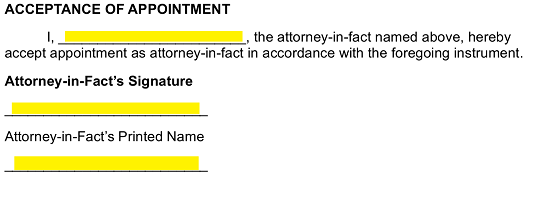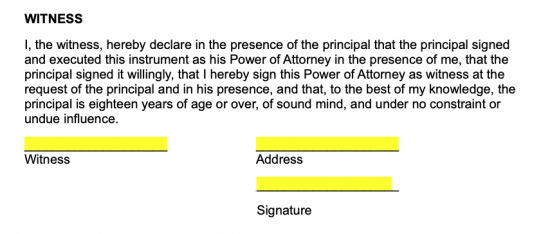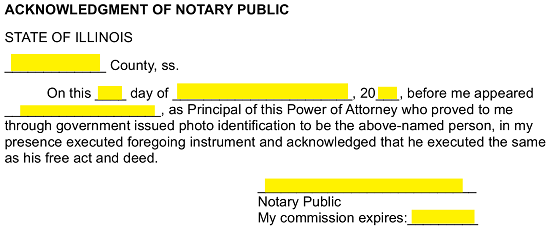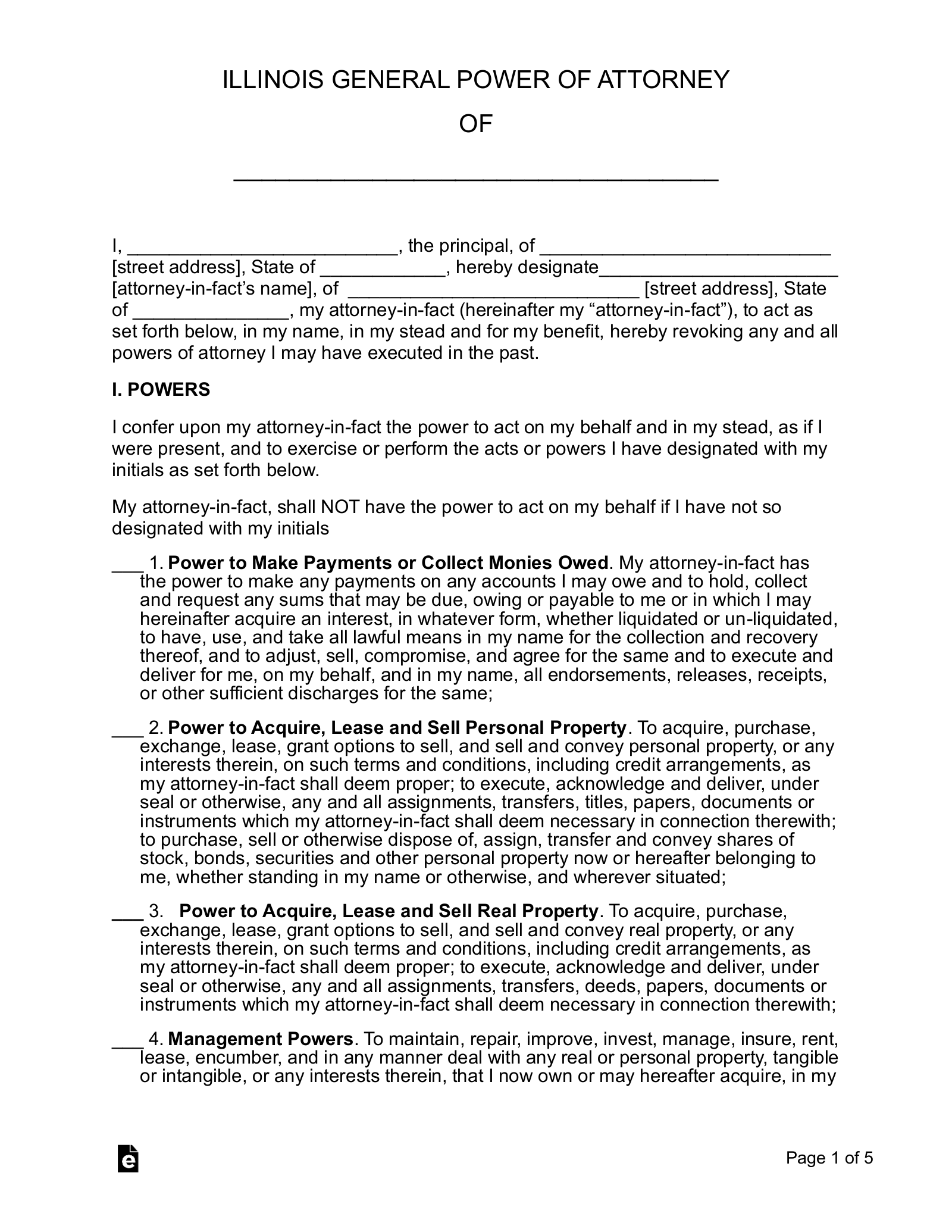Updated August 08, 2023
An Illinois general power of attorney permits an individual to grant personal financial authority to another person so that person can act in their place. Many people put a power of attorney in place when they anticipate being away and want someone to be able to make decisions or enter into transactions that they are unable to while they are away. This particular form only stays in effect until you revoke or become incapacitated.
Laws
- Statutes – Illinois Power of Attorney Act (§§ 45/1-1 — 45/4-12)
- Authority (755 ILCS 45/3-4) – An agent under a power of attorney may act on behalf of the principal and exercise broad authority as granted by the agreement.
- Signing Requirements (755 ILCS 45/3-3): One (1) witness and a notary public.
How to Write
Download: PDF, MS Word, OpenDocument
1 – The Identity Of The Principal Must Be Prominently Displayed
Find the blank line immediately below the Title of this form. Use this blank space to enter the Full Name of the Principal.
2 – The Principal Identity Must Be Properly Specified
The introduction will seek to specify the Identity of The Principal by calling for his or her Address. This should be the Address that appears on his or her legal documents and I.D. Cards. First, enter the Principal’s Name on the blank line presented between the word “I” and “the principal…” The next available blank space, labeled “[street address],” should have the Principal’s Residential Building/House Number, Street Name, (if relevant) Suite Number, and County (or City) entered on it.
The next available blank space, labeled “[street address],” should have the Principal’s Residential Building/House Number, Street Name, (if relevant) Suite Number, and County (or City) entered on it.
 The final required piece of information for this purpose is to enter the State where the Principal’s Address is located on the blank space after “State of.”
The final required piece of information for this purpose is to enter the State where the Principal’s Address is located on the blank space after “State of.”

3 – The Intended Attorney-in-Fact’s Identity And Fact Must Be Presented
The Principal will officially declare the Attorney-in-Fact intended to act with Principal Authority by reporting the Attorney-in-Fact’s Full Name on the space following the phrase “hereby designate.” The Attorney-in-Fact’s Residential Address should be reported on the next blank line by entering his or her Building/House Number, Street Name, Suite Number (if relevant), and County or City.
The Attorney-in-Fact’s Residential Address should be reported on the next blank line by entering his or her Building/House Number, Street Name, Suite Number (if relevant), and County or City.  Finally, enter the State where the Attorney-in-Fact resides on the blank line after the words “State of.”
Finally, enter the State where the Attorney-in-Fact resides on the blank line after the words “State of.”
4 – The Attorney-in-Fact’s Principal Powers Should Be Clearly Defined
The first section “Powers” will provide a list of the types of Authority most commonly assigned to an Attorney-in-Fact by the Principal. If left as is, this document will assign all the Powers of Authority to the Attorney-in-Fact named here. If there are any subjects of Authority that should be held from the Attorney-in-Fact, the Principal will need to initial the blank space preceding the numbered paragraph defining that power. There will be sixteen items for the Principal or Grantor to review. Only the Principal may initial the blank space to withhold the specified matter of Authority from being assigned to the Attorney-in-Fact’s Principal Powers.
If the Principal intends for the Attorney-in-Fact to have the power to Pay and Collect Money, in the manner defined in the first item, then nothing will need to be done. However, if the Principal wishes to withhold such powers from the Attorney-in-Fact, he or she should initial the blank line just before the number 1.  The Principal, or Grantor, may choose to deny the Attorney-in-Fact access or authority over his or her Personal Property. This Authority is delivered in the second item. If the Grantor does not wish the Attorney-in-Fact or Grantee to have such Authority, then Item 2 must be initialed.
The Principal, or Grantor, may choose to deny the Attorney-in-Fact access or authority over his or her Personal Property. This Authority is delivered in the second item. If the Grantor does not wish the Attorney-in-Fact or Grantee to have such Authority, then Item 2 must be initialed.
 The Third Item shall define the Principal Authority regarding Real Property that will be delivered through this document’s execution. If the Grantor does not wish to deliver these types of Powers to the Attorney-in-Fact, he or she must initial the Third Item.
The Third Item shall define the Principal Authority regarding Real Property that will be delivered through this document’s execution. If the Grantor does not wish to deliver these types of Powers to the Attorney-in-Fact, he or she must initial the Third Item.
 Item 4 will specify the actions the intended Attorney-in-Fact may take on behalf of the Principal regarding Management over the types of property defined. The Principal should read this carefully then determine whether these powers should be granted or not by initialing Item 4 to withhold them or leaving it as is to grant them.
Item 4 will specify the actions the intended Attorney-in-Fact may take on behalf of the Principal regarding Management over the types of property defined. The Principal should read this carefully then determine whether these powers should be granted or not by initialing Item 4 to withhold them or leaving it as is to grant them.
The Banking Powers defined in the Fifth Item will be granted to the Attorney-in-Fact unless the Principal initials the blank space preceding this paragraph
The Principal may have control or ownership over various vehicles. The actions, powers, and vehicle types where the Agent may wield Principal Power are specified in Item 6. If such actions are to be withheld, the Principal should

The Seventh Item will define how the Attorney-in-Fact may behave regarding the Principal’s Taxes. The Principal should make sure to read this item carefully. If he or she does not want to grant a power or powers regarding his or her Taxes to the Attorney-in-Fact, then he or she should initial Item 7.
The Eighth Item will grant access and Authority regarding the Principal’s Safe-Deposit Boxes. To prevent such a granting of power, initial the blank space before the number 8.

The Attorney-in-Fact will have Gift Making Powers through this document if Item 9 is left alone. This may also be withheld by the Principal’s initials.
The Tenth Item, “Lending and Borrowing,” shall provide the language for the Principal to grant Authority regarding the Principal’s Money in terms of Lending and Borrowing it (this will include such items as mortgages and personal property). The Attorney-in-Fact will be prevented from assuming such powers by virtue of the Principal’s initials in Item 10. ![]() The Eleventh subject matter concerns Contracts. That is, unless the Principal wishes the Attorney-in-Fact to act in his or her name regarding contractual agreements, he or she should initial Item 11.
The Eleventh subject matter concerns Contracts. That is, unless the Principal wishes the Attorney-in-Fact to act in his or her name regarding contractual agreements, he or she should initial Item 11. ![]() The ability to act with respect to the Principal’s Health Care will be provided to the Attorney-in-Fact through Item 12. The Grantor of the powers in this document may choose to withhold such decision-making.
The ability to act with respect to the Principal’s Health Care will be provided to the Attorney-in-Fact through Item 12. The Grantor of the powers in this document may choose to withhold such decision-making.
powers by simply initialing Item 12. The Power defined in the Health Insurance Portability and Accountability Act of 1996 will be granted to the Attorney-in-Fact named in this form so long as the Principal does not initial item 13.
The Power defined in the Health Insurance Portability and Accountability Act of 1996 will be granted to the Attorney-in-Fact named in this form so long as the Principal does not initial item 13. 
The Fourteenth subject matter allows the Attorney-in-Fact with the ability to Hire and Pay for the Services defined within it on behalf of the Principal. If this is not in line with Principal wishes then, he or she should initial the blank line provided.

The Fifteenth subject matter will cover the Reimbursement issue of the Attorney-in-Fact. Should the Principal wish to grant the Agent the ability to gain reimbursement then Item 15 should be left alone. Otherwise, Item 15 must be initialed by the principal to withhold this power from the Agent. ![]()
The Sixteenth Item defines the Power to Sue Third Parties who do not recognize the Principal Authority afforded to the Agent through the execution of this document. If the Principal wishes to grant this type of power to the Agent, he or she may leave this item unmarked. If this should not be a power granted to the Principal, then he or she must initial the blank line preceding Item 16.
Item 17 provides the area required should the Principal need to specify a Power or Authority the Agent may wield that has not been defined in this list. The Principal does not need to initial this item, only leave it blank, if no additional powers should be granted.
5 – The Period When The Attorney-in-Fact May Wield Principal Authority Must Be Clearly Documented
This document will present several options for its Effective Period Start Date. In “Effective Date and Termination,” the Principal may choose one of two options for the Start Date. If the Start Date is the Date of Signature, the Principal should initial the first option (“Upon the date…”). However, if there is a specific Start Date, it may be specified in the second option after the Principal initials the blank space preceding it (“The following date”).
Next, there will be three options provided to define the Termination Date of this document. If there is a specific desired Date of Termination, the Principal should initial the first choice then enter the preferred Termination Date on the blank line. The second option will provide the Termination to be dependent upon a Written Revocation issued by the Principal and may be selected by initialing the blank space. The final option will also name an event to mark the Termination by setting this Authority’s Termination Date as any Date the Principal becomes incapacitated or unable to make a decision (according to a Physician’s Diagnosis). To select the third option, the Principal must initial the blank line preceding the words “When and if…”
6 – This Document Must Be Dated Then Executed By Principal Signature
After reading the final paragraphs in the “Third Party Reliance,” section, the Principal must provide the Date he or she is signing this form in the last paragraph.![]()
Once the Date of Signature has been provided, the Principal must sign and print his or her Name on the blank lines provided.
7 – Several Other Parties Should Attend To This Form
The next area, “Acceptance of Appointment,” has been provided for the Attorney-in-Fact’s attention. He or she must Prion his or her Name on the blank line in the statement present. Then, the Attorney-in-Fact must Sign and Print his or her name in the appropriate areas.  Below the Attorney-in-Fact statement will be a Witness Statement. The one (1) Witness attending the signing of this document must sign and print their name and provide a current Address in the spaces provided.
Below the Attorney-in-Fact statement will be a Witness Statement. The one (1) Witness attending the signing of this document must sign and print their name and provide a current Address in the spaces provided.

Finally, once these tasks have been completed before a Notary Public, this entity will complete and notarize this document in the “Acknowledgment of Notary Public” section.


